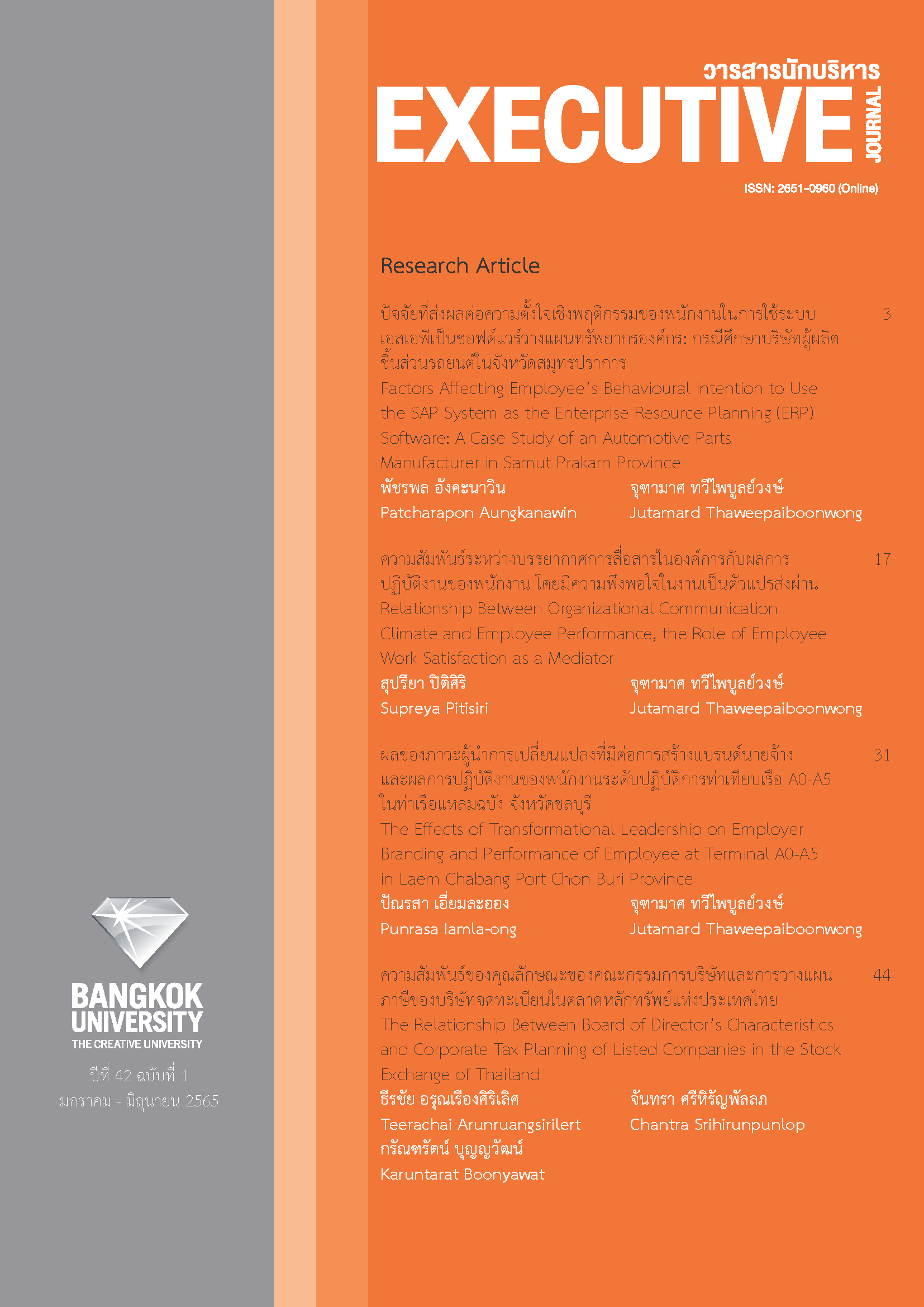ความพึงพอใจในชีวิตของพนักงานธนาคาร: บทบาทของตัวแปรคั่นกลางความสมดุลระหว่างชีวิตและการทำงาน
Main Article Content
บทคัดย่อ
งานวิจัยนี้มีวัตถุประสงค์เพื่อศึกษาปัจจัยที่ส่งผลต่อความสมดุลระหว่างชีวิตและการทำงานและความพึงพอใจในชีวิตของพนักงานธนาคาร และเพื่อศึกษาบทบาทการคั่นกลางของความสมดุลระหว่างชีวิตและการทำงานที่มีต่อความพึงพอใจในชีวิตของพนักงานธนาคาร ประกอบด้วย 6 ปัจจัยดังนี้ ความบ้างาน ความเครียดจากการทำงาน ผู้นำเน้นคน การรับรู้การสนับสนุนจากทีม การรับรู้การสนับสนุนจากครอบครัว และด้านสวัสดิการ กลุ่มตัวอย่างที่ใช้ในการศึกษา คือ พนักงานธนาคารพาณิชย์แห่งหนึ่งจำนวน 225 คน เก็บข้อมูลโดยใช้แบบสอบถามออนไลน์ วิเคราะห์ข้อมูลโดยใช้โมเดลสมการโครงสร้าง ผลการวิจัยพบว่า ที่ระดับมีนัยสำคัญทางสถิติที่ 0.05 ความบ้างานมีอิทธิพลทางตรงเชิงลบต่อความสมดุลระหว่างชีวิตและการทำงาน ผู้นำเน้นคนและด้านสวัสดิการมีอิทธิพลทางตรงเชิงบวกต่อความสมดุลระหว่างชีวิตและการทำงาน ตามลำดับ การรับรู้การสนับสนุนจากครอบครัวและด้านสวัสดิการมีอิทธิพลทางตรงเชิงบวกต่อความพึงพอใจในชีวิต ตามลำดับ และพบว่าความสมดุลระหว่างชีวิตและการทำงานเป็นตัวแปรคั่นกลางระหว่างความบ้างานกับความพึงพอใจในชีวิต ผู้นำเน้นคนกับความพึงพอใจในชีวิต และด้านสวัสดิการกับความพึงพอใจในชีวิต
Article Details

อนุญาตภายใต้เงื่อนไข Creative Commons Attribution-NonCommercial-NoDerivatives 4.0 International License.
บทความที่นำมาสมัครลงตีพิมพ์ในวารสารต้องไม่เคยได้รับการตีพิมพ์เผยแพร่มาก่อน และไม่ส่งต้นฉบับบทความซ้ำซ้อนกับวารสารอื่น รวมทั้งผู้เขียนบทความต้องไม่ละเมิดหรือคัดลอกผลงานของผู้อื่น
เอกสารอ้างอิง
Abendroth, A. K., & Den Dulk, L. (2011). Support for the work-life balance in Europe: The impact of state, workplace and family support on work-life balance satisfaction. Work, Employment and Society, 25(2), 234-256.
Adams, A. G., King, A. L., & King, W. D. (1996). Relationships of job and family involvement, familysocial support, and work-family conflict with job and life satisfaction. Journal of
Applied Psychology, 81(4), 411-420.
Andreassen, C. S., Pallesen, S., & Torsheim, T. (2018). Workaholism as a mediator between work-related stressors and health outcomes. International Journal of Environmental Research and Public Health, 15(1), 73.
Aziz, S., & Cunningham, J. (2008). Workaholism, work stress, work-life imbalance: exploring gender’s role. Gender in Management: An International Journal, 23(8), 553-566.
Bakker, A. B., & Demerouti, E. (2007). The job demands-resources model: State of the art. Journal of Managerial Psychology, 22(3), 309-328.
Bernarto, I., Bachtiar, D., Sudibjo, N., Suryawan, I. N., Purwanto, A., & Asbari, M. (2020). Effect of transformational leadership, perceived organizational support, job satisfaction toward life satisfaction: Evidences from Indonesian teachers. International Journal of Advanced Science and Technology, 29(3), 5495–5503.
Binder, M., & Coad, A. (2013). Life satisfaction and self-employment: A matching approach. Small Business Economics, 40(4), 1009-1033.
Brough, P., Timms, C., Chan, X. W., Hawkes, A., & Rasmussen, L. (2020). Work–life balance: Definitions,
causes, and consequences. In T. Theorell (Ed.), Handbook of socioeconomic determinants of occupational health: From macro-level to micro-level evidence (pp. 1-15). Switzerland: Springer Nature.
Cain, L., Busser, J., & Kang, H. J. (2018). Executive chefs’ calling: Effect on engagement, work-life balance and life satisfaction. International Journal of Contemporary Hospitality Management, 30(5), 2287-2307.
Cooper, C. L., & Marshall, J. (1976). Occupational source of stress: A review of the literature relating to coronary heart disease and mental ill health. Journal of Occupational Psychology, 49(1), 11-28.
Eisenberger, R., Huntington, R., Huntchison, S., & Sowa, D. (1986). Perceived organizational support. Journal of Applied Psychology, 71(3), 500-507.
Fleishman, E. A. (1951). Leadership climate and supervisory behavior: A study of the leadership role of the foreman in an industrial situation. Columbus, Ohio: Ohio State University Personnel Research Board.
Fornell, C., & Larcker, D. F. (1981). Evaluating structural equation models with unobservable variables and measurement error. Journal of Marketing Research, 18(1), 39–50.
Ogola, M., Sikalieh, D., & Linge, K. T. (2017). The Influence of intellectual stimulation leadership behaviour on employee performance in SMEs in Kenya. International Journal of Business and Social Science, 8(3), 89-100.
Haar, J. M., Russo, M., Suñe, A., & Ollier-Malaterre, A. (2014). Outcomes of work–life balance on job satisfaction, life satisfaction and mental health: A study across seven cultures. Journal of Vocational Behavior, 85(3), 361-373.
Hair, J. F., Black, W. C., Babin, B. J., & Anderson, R. E. (2019). Multivariate data analysis: Pearson new international (8th ed.). Pearson Education: Annabel Ainscow.
Le, H., Newman, A., Menzies, J., Zheng, C., & Fermelis, J. (2020). Work–life balance in Asia: A systematic
review. Human Resource Management Review, 30(4), 100766.
Malik, M., Wan, D., Dar, L., Akbar, A., & Naseem, M. A. (2014). The role of work life balance in job satisfaction and job benefit. Journal of Applied Business Research, 30(6), 1627-1638.
Margolis, B. L., Kroes, W. H., & Quinn, R. P. (1974). Job stress: an unlisted occupational hazard. Journal of Occupational Medicine, 16(10), 659-661.
Mathew, R. V., & Panchanatham, N. (2011). An exploratory study on the work-life balance of woman entrepreneurs in South India. Asian Academy of Management Journal, 16(2), 77–105.
Mondy, R. W., & Noe, R. M. (2005). Human resource management (9th ed.). Upper Saddle River, NJ: Pearson Prentice Hall.
Muguongo, M. M., Muguna, A. T., & Muriithi, D. K. (2015). Effects of compensation on job satisfaction among secondary school teachers in Maara Sub-County of Tharaka Nithi County, Kenya. Journal of Human Resource Management, 3(6), 47-59.
Noda, H. (2020). Work–life balance and life satisfaction in OECD countries: A cross-sectional analysis. Journal of Happiness Studies, 21(4), 1325-1348.
Parker, D. F., & DeCotiis, T. A. (1983). Organizational determinants of job stress. Organizational Behavior and Human Performance, 32(2), 160-177.
Pearce, C. L., & Herbik, P. A. (2004). Citizenship behavior at the team level of analysis: The effects of team leadership, team commitment, perceived team support, and team size. The Journal of Social Psychology, 144(3), 293-310.
Rinthaisong, T. (2021). Kān wikhro̜ mōdēn samakān khrōngsāng samrap kānwičhai thāng phrưttikammasāt læ sangkhommasāt [Structural equation modeling for behavioral and social sciences research]. Songkla: Neo point (1995).
Russo, M., Shteigman, A., & Carmeli, A. (2016). Workplace and family support and work–life balance: Implications for individual psychological availability and energy at work. The Journal of Positive Psychology, 11(2), 173-188.
Shagvaliyeva, S., & Yazdanifard, R. (2014). Impact of flexible working hours on work-life balance. American Journal of Industrial and Business Management, 4(1), 20-23.
Sirgy, M. J., & Lee, D. J. (2018). Work-life balance: An integrative review. Applied Research in Quality of Life, 13(1), 229-254.
Teufel-Shone, N. I., Staten, L. K., Irwin, S., Rawiel, U., Bravo, A. B., & Waykayuta, S. (2005). Family cohesion and conflict in an American Indian community. American Journal of Health Behavior, 29(5), 413-422.
Vitiello, K., Aziz, S., & Wuensch, K. L. (2016). Workaholism and authenticity: The role of life satisfaction. Journal of Behavioral and Applied Management, 17(2), 116-133.
Wallace, C. J., Edwards, D. B., Arnold, T., & Finch, M. D. (2009). Work stressors, role-based performance,
and the moderating influence of organizational support. Journal of Applied Psychology, 94(1), 254-262.
Yang, X., Qiu, D., Lau, M. C., & Lau, J. T. (2020). The mediation role of work-life balance stress and chronic fatigue in the relationship between workaholism and depression among Chinese male workers in Hong Kong. Journal of Behavioral Addictions, 9(2), 483-490.


